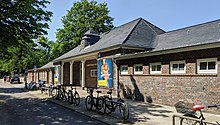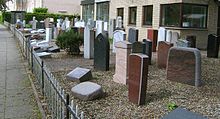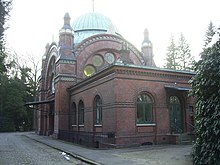Hamburg-Ohlsdorf
|
Ohlsdorf district of Hamburg |
|
|---|---|
| Coordinates | 53 ° 37 '33 " N , 10 ° 1' 53" E |
| surface | 7.2 km² |
| Residents | 16,666 (Dec. 31, 2019) |
| Population density | 2315 inhabitants / km² |
| Post Code | 22309, 22335, 22337, 22391 |
| prefix | 040 |
| district | Hamburg North |
| Transport links | |
| Train |
|
| Subway |
|
| Source: Statistical Office for Hamburg and Schleswig-Holstein | |
Ohlsdorf ( Low German : Oolsdkör ) is a district in the Hamburg-Nord district of the Free and Hanseatic City of Hamburg .
geography
Ohlsdorf borders in the north on Hummelsbüttel , in the east on Wellingsbüttel , Bramfeld and Steilshoop , in the south on Barmbek-Nord and in the west on Alsterdorf and Fuhlsbüttel . The Alster forms the border to Hummelsbüttel and partly to Fuhlsbüttel and Alsterdorf.
district
Since the area mainly consists of cemetery grounds, Klein Borstel and the southern part of Fuhlsbüttel also belong administratively to the Ohlsdorf district - including the Fuhlsbüttel penal institution , known as Santa Fu .
history
The name Ohlsdorf, derived from Odelverstorpe , refers to a village founded in the Schauenburg era by a man named Odulf. The first documentary mention comes from the year 1303, when Adolf V confirmed the high and low jurisdiction of the family from Berge . In 1366 the Harvestehude monastery bought the land, after the Reformation it fell to the Hamburg Johanniskloster . In the 19th century, Ohlsdorf was assigned to the rulership of the Geestlande as part of a reorganization of the Hamburg rural area .
In the second half of the 19th century, the “Forsthof” on the southern border of the district towards Barmbek became a popular excursion restaurant. It had a ballroom, a large garden and rooms to sleep in. A large festival meadow was also set up in the 1920s. Until the Second World War, the restaurant was used for large evening events. After the war, the area was initially used as a concrete plant. There is now a famila store on the area .
statistics
- Minor quota: 16.6% [Hamburg average: 16.3% (2017)].
- Elderly rate: 16.3% [Hamburg average: 18.2% (2017)].
- Proportion of foreigners: 12.1% [Hamburg average: 17.1% (2017)].
- Unemployment rate: 4.1% [Hamburg average: 5.2% (2017)].
The average income per taxpayer in Ohlsdorf is 39,049 euros annually (2013), the Hamburg average is 39,054 euros.
politics
The now no longer existing home for the closed accommodation of young people in the Feuerbergstrasse was the subject of controversial discussions and political clashes.
For the election to Hamburg citizenship , Ohlsdorf belongs to the constituency of Fuhlsbüttel-Alsterdorf-Langenhorn . The 2020 general election brought the following result:
- SPD : 37.9% (−7.7)
- Greens : 29.1% (+16.5)
- CDU : 14.5% (−4.7)
- Left : 7.2% (+0.2)
- FDP : 4.5% (−1.2)
- AfD : 5.5% (−1.1)
- DiB : 1.2% (+1.2)
Culture and sights
Cemeteries in Ohlsdorf
The Ohlsdorf main cemetery is located in Ohlsdorf , the largest park cemetery in the world. In addition to this urban burial site, there is also the cemetery of the Hamburg Jewish community ( Jüdischer Friedhof Ilandkoppel ) in the district.
traffic



tram
The tram operated from downtown Hamburg via Barmbek to Ohlsdorf was given line number 6 in 1900. At the end of May 1965, this tram line was discontinued and a broken system with a bus line (72 to Barmbek station) and rapid transit (U- or S-Bahn) from Barmbek station). The building of the tram stop in the green ground is still preserved today.
Train
Since December 5, 1906, Ohlsdorf has been connected to Hamburg's rapid transit network via the Hamburg-Altona urban and suburban railway station of the same name . The route was electrified just one year later. At the same time, a depot was set up for the maintenance of the multiple units, it is today's maintenance depot Ohlsdorf with newer technology
On January 15, 1918, the Alstertal Railway to Poppenbüttel was also temporarily put into operation. It was first used by benzene railcars and in 1924 it was integrated into the suburban railway network. Today the lines S1 and S11 of the Hamburg S-Bahn operate here .
In December 2008 the airport S-Bahn from Ohlsdorf to Fuhlsbüttel Airport (Hamburg Airport) opens.
Subway
On December 1, 1914, two additional platforms for the trains of the Hamburger Hochbahn (today's line U1 ) were put into operation west of the existing city platform , which returned here for the next six and a half years - until the takeover of operations on the Langenhorner Bahn . Passenger traffic on this line from Ohlsdorf to Langenhorn ( Ochsenzoll ) was opened after some circumstances due to the First World War on January 5, 1918, initially with a steam train on the existing freight track.
See also
- List of streets and bridges in Hamburg-Ohlsdorf
- List of cultural monuments in Hamburg-Ohlsdorf
- List of stumbling blocks in Hamburg-Ohlsdorf
literature
- Silke Kaiser, Hans Matthaei: Bathing in the Alsterwasser - history of the bathing establishment Ohlsdorf . Hamburg 1992 (available from Willi-Bredel-Gesellschaft Geschichtswerkstatt e.V.)
- Herbert Diercks : Ohlsdorf Cemetery - On the trail of Nazi rule and resistance . Hamburg 1992, ISBN 3-87916-012-0
- Ursel Hochmuth : Nobody and nothing is forgotten, biograms of Hamburg resistance fighters 1933–1945 , Ehrenhain documentation Friedhof Ohlsdorf. Hamburg 2005, ISBN 3-89965-121-9
Web links
Individual evidence
- ^ Horst Beckershaus: The names of the Hamburg districts. Where do they come from and what they mean , Hamburg 2002, ISBN 3-434-52545-9 , p. 94
- ^ Bernhard Beyerlein, district analysis . A guide to exploring neighborhoods . Society for Sociological Urban Research, Hamburg 1986
- ↑ Quota of minors in the Hamburg districts in 2017
- ↑ Proportion of 65-year-olds and older in the Hamburg districts in 2017
- ↑ Proportion of foreigners in the Hamburg districts in 2017
- ↑ Unemployment rate in the Hamburg districts in 2017
- ↑ Statistical Office for Hamburg and Schleswig-Holstein (ed.): Hamburg District Profile 2016 (= NORD.regional . Volume 19 ). 2018, ISSN 1863-9518 ( Online PDF 6.6 MB [accessed February 12, 2018]).
- ↑ election result in www.wahlen-hamburg.de
- ↑ https://commons.wikimedia.org/wiki/File:Ehemalige_Stra%C3%9Fenbahnhaltestelle_Ohlsdorf_in_der_Stra%C3%9Fe_Am_Gr%C3%BCnen_Grunde_in_Hamburg-Ohlsdorf_1.jpg




